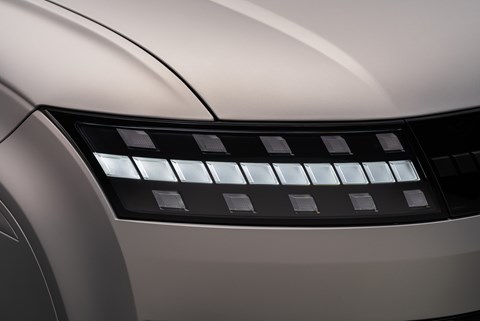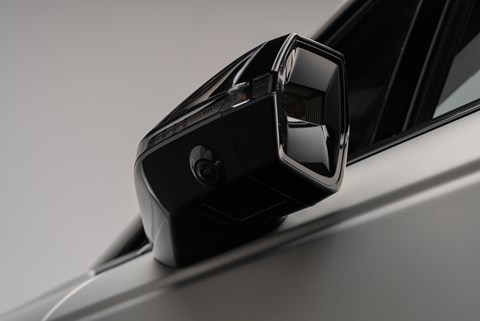► Hyundai’s flagship Ioniq 9 has arrived
► Design follows on from Seven concept
► Flexible seats, big battery and tech overload
Hyundai has revealed its new Ioniq 9 SUV – the flagship electric model for its sub-brand that’ll be the star of the 2024 LA Auto Show.
As the number suggests, the Ioniq 9 is the biggest EV Hyundai has created, with the new EV offering huge space and plenty of flexibility for the family. We have been up close and personal with the Ioniq 9 in Los Angeles ahead of its reveal – this is everything you need to know.
That is… big
Isn’t it just. In fact, the Ioniq 9 is so large that it’s taller, longer and has a longer wheelbase than the Palisade SUV – a ‘full-size’ model that’s sold in North America. It measures in at 5060mm in length, 1980mm in width and 1970mm tall. Hyundai also says it has the longest wheelbase of any production car the brand has ever built, at 3170mm.

For European context, that makes it slightly longer than a Range Rover, as well as the Kia EV9 – a sibling to the Hyundai. That said, when you’re stood next to it, it doesn’t actually feel as large as it looks – almost the opposite effect (to our eye, anyway) as the design effects of the Ioniq 5.
There are naturally plenty of design details meant to link it to the rest of the Ioniq range. Simon Loasby, head of Hyundai’s design centre, talks of chess pieces and how they belong to the same family, but have unique details. You can still see the brand’s ‘parametric pixel’ lights front and rear, but the Ioniq 9 has had inspiration taken from yachts and engineering. Depending on colour and spec, plenty of elements in the wheelarches will be black, rather than entirely body-coloured; Hyundai offers a range of colours beyond this pretty drab satin colour, including a fantastic dark green.

We first saw how the Ioniq 9 would look with the Seven Concept. ‘Usability was the main thing we wanted to carry across [from concept to production],’ Loasby tells CAR, ‘as well as the practicality of the space and the efficiency of how the car moves through the air. We could have gone quite boxy and give a daunting impression to the car, but we already have Palisade and Santa Fe – we don’t necessarily need everything in that boxy camp.’ Loasby points to the very rounded front end and steeply raked windscreen that are designed to cut through the air better and leave less of an imposing shape in other drivers’ rear-view mirrors – so much so that the Ioniq 9 boasts a reasonably slippery 0.269Cd drag co-efficient, or 0.259 with optional camera mirrors.

Why not call this an Ioniq 7, to carry on the naming convention from the concept car? ‘We wanted to create space in the range,’ says Loasby. ‘It’s our biggest car here, so we’re creating space for who knows what in between.’ Naturally, an Ioniq 7 and Ioniq 8 are on the way in the future.
And it’s about being smart inside?
That’s the plan. Naturally, there are a lot of classic Hyundai design cues inside, including two wide displays that sit on top of the dashboard for the drivers’ instruments and main infotainment display and a chunky steering wheel. Recycled materials are everywhere, and the interior can be had in a range of colours.

But, given this is a family bus, Hyundai’s played as many utilitarian cards as it can. When sat in the front, what you’ll notice is a completely open centre console area allowing you to jump between seats easily. Nestled between the front seats is the Universal Island 2.0 – a large storage area that can slide fore and aft, even as far back as the second row. There are switches and charging areas on board, as well as climate controls for the rear occupants and an armrest storage lid that can be opened both ways. Elsewhere, Hyundai has included a UV sanitisation station for your devices and its software allows you to download new features after you’ve bought the car.

Utilising the E-GMP platform’s flat floor allows loads of flexibility in the second and third row. Like the EV9, the Hyundai Ioniq 9 can be had with a more conventional seven-seat configuration or a six-seat layout that features two captain’s chairs in the second row. If you choose the six-seat layout, those second-row chairs include Hyundai’s ‘relaxation seat’ technology that allows them to recline far and feature a leg rest, and can be kitted out with massaging functions. They also can swivel, allowing for easy entry and exit or giving those inside the opportunity to turn around 180-degrees to sit face-to-face with those in the third row. Hyundai points out that you can only turn the chairs around when the car is stationary.

Space is impressive, too. During our time with the car, we sat in all three rows. I’m 6’2” and managed to find the third row easy to get into and comfortable once I was in place. All three rows feature cupholders and charge points. As for boot volume, Hyundai quotes a 620-litre space with all three rows up and 1323 litres with the third row folded down. There’s also a frunk – useful for charging cables and so on – that either holds 88 litres in the rear-driven models, or 52 litres in the all-wheel drive models.
Sounds like a range of specs, then
Of course. Given the wheelbase stretch, the Ioniq 9 features the largest battery ever housed in an E-GMP car: 110.3kWh, which is standard across all variants.
The Ioniq 9 comes in three performance flavours, and they’re a bit self-explanatory: Long Range RWD, Long Range AWD and Performance AWD. Hyundai is still homologating the Ioniq 9’s variants, but we have certain range and performance specs for certain models.
Long Range RWD
Power output: Single e-motor, 215bhp, 258lb ft
0-60mph: 8.4sec (0-62mph TBC)
Top speed: TBC
Range: 385 miles (WLTP projected)
Long Range AWD
Power output: Two e-motors, 309bhp, 446lb ft
0-60mph: 6.2sec (0-62mph TBC)
Top speed: 124mph
Range: TBC
Performance AWD
Power output: Two e-motors, 429bhp, 516lb ft
0-62mph: 5.2sec
Top speed: 124mph
Range: TBC
Proper European trim level specs haven’t been confirmed yet, but we’d expect the trim walk-up to start with Premium and rise to Ultimate and Calligraphy. If the Ioniq 9 is anything like any other high-end Hyundai model, expect even the ‘base’ Premium trim to have plenty on it.

We also predict that the Ioniq 9 will inevitably benefit from an N-Line trim variant later down the car’s production run. But, what about a full-fat N? Maybe. ‘At the end of the day, [the Ioniq 9] is a big, heavy car and it consumes a hell of a lot of power,’ says Loasby, ‘so maybe for some of our cars it’s not as appropriate as others, but we feel our brand can stretch that far. I think the progression for N will be to tap into more sophistication with the performance, and here we have a car that is super sophisticated.’
Given this is an E-GMP car, the Ioniq 9 runs an 800-volt electrical architecture that allows for 350kW fast charging – Hyundai claims 24 minutes from 10-80 per cent at that peak rate. Here, though, the Ioniq 9 can switch to running its electric systems at 400-volts to ensure fast charging on older chargers. The brand’s vehicle-to-load technology also features, accessed via an adapter like on the Ioniq 5 and Ioniq 6.
Hyundai also points to the Ioniq 9’s Chassis Domain Control Unit that’s designed to help keep the car stable in cornering, while triple-glazed glass and active noise cancellation aims to keep the cabin quiet at speed. Camera mirrors are on the options list, too.

The Ioniq 9 runs a conventional multi-link suspension system front and rear – no air springs here, or rear-wheel steering for that matter – but says the rear features self-levelling dampers. Euro-spec Ioniq 9 models can also tow up to 2500kg.
When can I buy an Ioniq 9?
Hyundai says the Ioniq 9 will go on sale in Korea and North America in early 2025, with other markets to follow later on in the year.